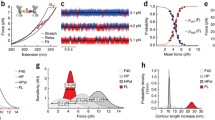Abstract
Genetically encoded Förster Resonance Energy Transfer (FRET)-based tension sensors were developed to enable the quantification of piconewton (pN)-scale forces that act across distinct proteins in living cells and organisms. An important extension of this technology is the multiplexing of tension sensors to monitor several independent FRET probes in parallel. Here we describe how pulsed interleaved excitation (PIE)-fluorescence lifetime imaging microscopy (FLIM) can be implemented to enable the analysis of two co-expressed tension sensor constructs. Our protocol covers all essential steps from biosensor expression and live cell PIE image acquisition to lifetime calculations.
Access this chapter
Tax calculation will be finalised at checkout
Purchases are for personal use only
Similar content being viewed by others
References
Hoffman BD, Grashoff C, Schwartz MA (2011) Dynamic molecular processes mediate cellular mechanotransduction. Nature 475(7356):316–323. https://doi.org/10.1038/nature10316
Petridou NI, Spiro Z, Heisenberg C-P (2017) Multiscale force sensing in development. Nat Cell Biol 19(6):581–588. https://doi.org/10.1038/ncb3524
Kanoldt V, Fischer L, Grashoff C (2019) Unforgettable force - crosstalk and memory of mechanosensitive structures. Biol Chem 400(6):687–698. https://doi.org/10.1515/hsz-2018-0328
Roca-Cusachs P, Conte V, Trepat X (2017) Quantifying forces in cell biology. Nat Cell Biol 19(7):742–751. https://doi.org/10.1038/ncb3564
Fischer LS, Rangarajan S, Sadhanasatish T et al (2021) Molecular force measurement with tension sensors. Annu Rev Biophys 50:595–616. https://doi.org/10.1146/annurev-biophys-101920-064756
Grashoff C, Hoffman BD, Brenner MD et al (2010) Measuring mechanical tension across vinculin reveals regulation of focal adhesion dynamics. Nature 466(7303):263–U143. https://doi.org/10.1038/nature09198
Austen K, Ringer P, Mehlich A et al (2015) Extracellular rigidity sensing by Talin isoform-specific mechanical linkages. Nat Cell Biol 17(12):1597–1606. https://doi.org/10.1038/ncb3268
Freikamp A, Cost A-L, Grashoff C (2016) The Piconewton force awakens: quantifying mechanics in cells. Trends Cell Biol 26(11):838–847. https://doi.org/10.1016/j.tcb.2016.07.005
Kanoldt V, Kluger C, Barz C et al (2020) Metavinculin modulates force transduction in cell adhesion sites. Nat Commun 11(1):6403. https://doi.org/10.1038/s41467-020-20125-z
Kumar A, Ouyang M, van den Dries K et al (2016) Talin tension sensor reveals novel features of focal adhesion force transmission and mechanosensitivity. J Cell Biol 213(3):371–383. https://doi.org/10.1083/jcb.201510012
Ringer P, Weißl A, Cost A-L et al (2017) Multiplexing molecular tension sensors reveals piconewton force gradient across Talin-1. Nat Methods 14(11):1090–1096. https://doi.org/10.1038/nmeth.4431
Hernández-Varas P, Berge U, Lock JG et al (2015) A plastic relationship between vinculin-mediated tension and adhesion complex area defines adhesion size and lifetime. Nat Commun 6:7524. https://doi.org/10.1038/ncomms8524
Rothenberg KE, Scott DW, Christoforou N et al (2018) Vinculin force-sensitive dynamics at focal adhesions enable effective directed cell migration. Biophys J 114(7):1680–1694. https://doi.org/10.1016/j.bpj.2018.02.019
Chang C-W, Kumar S (2013) Vinculin tension distributions of individual stress fibers within cell-matrix adhesions. J Cell Sci 126(Pt 14):3021–3030. https://doi.org/10.1242/jcs.119032
Price AJ, Cost A-L, Ungewiß H et al (2018) Mechanical loading of desmosomes depends on the magnitude and orientation of external stress. Nat Commun 9(1):5284. https://doi.org/10.1038/s41467-018-07523-0
Borghi N, Sorokina M, Shcherbakova OG et al (2012) E-cadherin is under constitutive actomyosin-generated tension that is increased at cell-cell contacts upon externally applied stretch. Proc Natl Acad Sci U S A 109(31):12568–12573. https://doi.org/10.1073/pnas.1204390109
Conway DE, Breckenridge MT, Hinde E et al (2013) Fluid shear stress on endothelial cells modulates mechanical tension across VE-cadherin and PECAM-1. Curr Biol 23(11):1024–1030. https://doi.org/10.1016/j.cub.2013.04.049
Nordenfelt P, Elliott HL, Springer TA (2016) Coordinated integrin activation by actin-dependent force during T-cell migration. Nat Commun 7:13119. https://doi.org/10.1038/ncomms13119
Krieg M, Dunn AR, Goodman MB (2014) Mechanical control of the sense of touch by β-spectrin. Nat Cell Biol 16(3):224–233. https://doi.org/10.1038/ncb2915
Déjardin T, Carollo PS, Sipieter F et al (2020) Nesprins are mechanotransducers that discriminate epithelial-mesenchymal transition programs. J Cell Biol 219(10). https://doi.org/10.1083/jcb.201908036
Carley E, Stewart RM, Zieman A et al (2021) The LINC complex transmits integrin-dependent tension to the nuclear lamina and represses epidermal differentiation. elife 10. https://doi.org/10.7554/eLife.58541
Lemke SB, Weidemann T, Cost A-L et al (2019) A small proportion of Talin molecules transmit forces at developing muscle attachments in vivo. PLoS Biol 17(3):e3000057. https://doi.org/10.1371/journal.pbio.3000057
Hirano S, Yamamoto T, Michiue T (2018) FRET-based tension measurement across actin-associated mechanotransductive structures using Lima1. Int J Dev Biol 62(9–10):631–636. https://doi.org/10.1387/ijdb.180110tm
Lagendijk AK, Gomez GA, Baek S et al (2017) Live imaging molecular changes in junctional tension upon VE-cadherin in zebrafish. Nat Commun 8(1):1402. https://doi.org/10.1038/s41467-017-01325-6
Tao H, Zhu M, Lau K et al (2019) Oscillatory cortical forces promote three dimensional cell intercalations that shape the murine mandibular arch. Nat Commun 10(1):1703. https://doi.org/10.1038/s41467-019-09540-z
Ham TR, Collins KL, Hoffman BD (2019) Molecular tension sensors: moving beyond force. Current Opinion in Biomedical Engineering 12:83–94. https://doi.org/10.1016/j.cobme.2019.10.003
Freikamp A, Mehlich A, Klingner C et al (2017) Investigating piconewton forces in cells by FRET-based molecular force microscopy. J Struct Biol 197(1):37–42. https://doi.org/10.1016/j.jsb.2016.03.011
Cost A-L, Ringer P, Chrostek-Grashoff A et al (2015) How to measure molecular forces in cells: a guide to evaluating genetically-encoded FRET-based tension sensors. Cell Mol Bioeng 8(1):96–105. https://doi.org/10.1007/s12195-014-0368-1
Demeautis C, Sipieter F, Roul J et al (2017) Multiplexing PKA and ERK1 & 2 kinases FRET biosensors in living cells using single excitation wavelength dual colour FLIM. Sci Rep 7. https://doi.org/10.1038/srep41026
Hendrix J, Lamb DC (2013) In: Digman MA, Stakic M, Gratton E (eds) Pulsed interleaved excitation: principles and applications, vol 518. Raster Image Correlation Spectroscopy and Number and Brightness Analysis, pp 205–243
Müller BK, Zaychikov E, Bräuchle C et al (2005) Pulsed interleaved excitation. Biophys J 89(5):3508–3522. https://doi.org/10.1529/biophysj.105.064766
Reissaus CA, Day KH, Mirmira RG et al (2020) PIE-FLIM measurements of two different FRET-based biosensor activities in the same living cells. Biophys J 118(8):1820–1829. https://doi.org/10.1016/j.bpj.2020.03.003
Author information
Authors and Affiliations
Corresponding author
Editor information
Editors and Affiliations
Rights and permissions
Copyright information
© 2023 The Author(s), under exclusive license to Springer Science+Business Media, LLC, part of Springer Nature
About this protocol
Cite this protocol
Windgasse, L., Grashoff, C. (2023). Multiplexed Molecular Tension Sensor Measurements Using PIE-FLIM. In: Zaidel-Bar, R. (eds) Mechanobiology. Methods in Molecular Biology, vol 2600. Humana, New York, NY. https://doi.org/10.1007/978-1-0716-2851-5_15
Download citation
DOI: https://doi.org/10.1007/978-1-0716-2851-5_15
Published:
Publisher Name: Humana, New York, NY
Print ISBN: 978-1-0716-2850-8
Online ISBN: 978-1-0716-2851-5
eBook Packages: Springer Protocols




